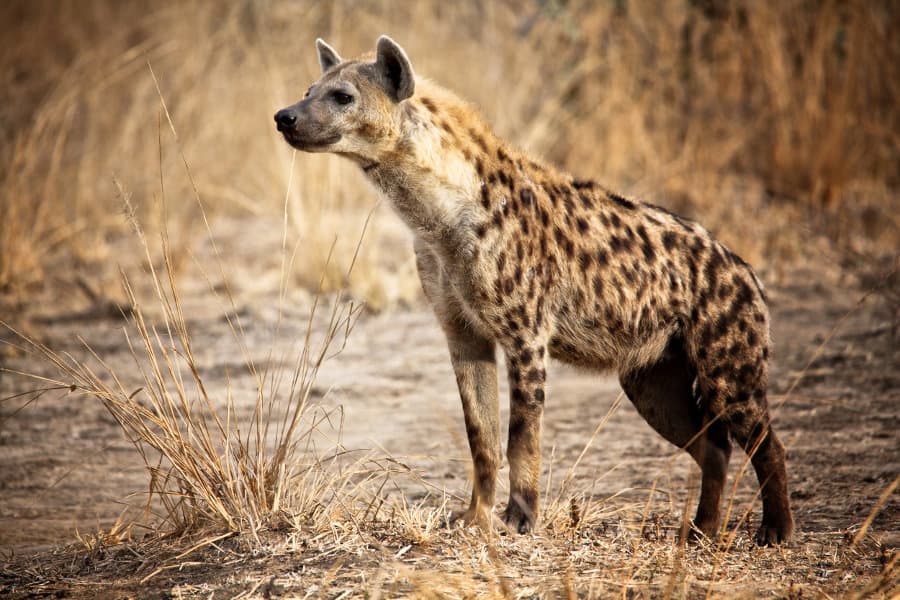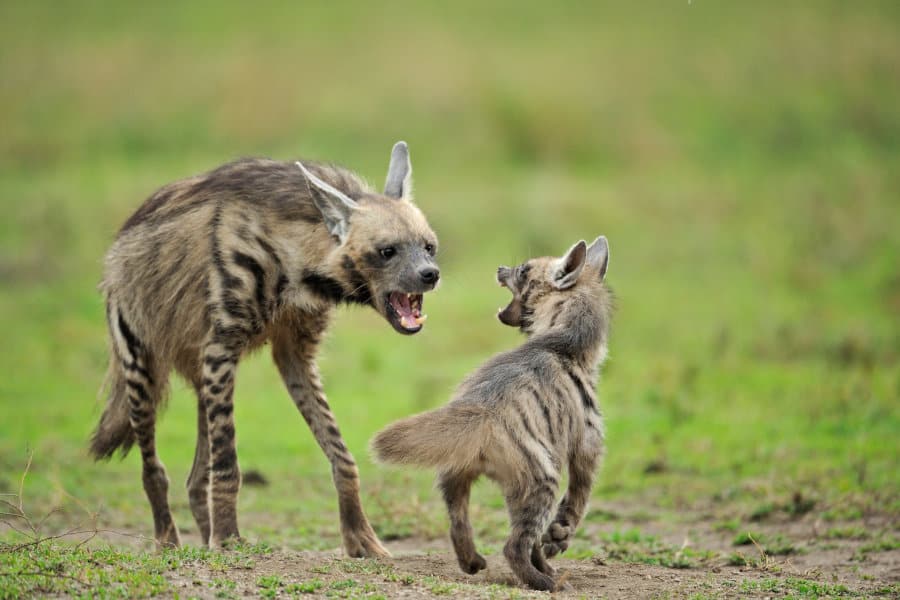Hyenas don’t have the best reputation in Africa, and their debut in the Lion King didn’t help them either. Although they’re not part of the Big Five, they’ve earned an unfortunate place in the Ugly Five. Luckily, their cubs are so adorable we’ll have to let the bad rep slide.
It’s tough being the youngster in a group of extremely strong females, who’ll often put the males to shame. So these scruffy pups have to put up quite the fight and prove themselves to the rest of the clan at a young age.
Although all the hyena species are awesome, we’ll be playing close attention to the most widespread of the hyenas. The cheeky, chatty spotted hyenas.
What Does a Hyena Pup Look Like?
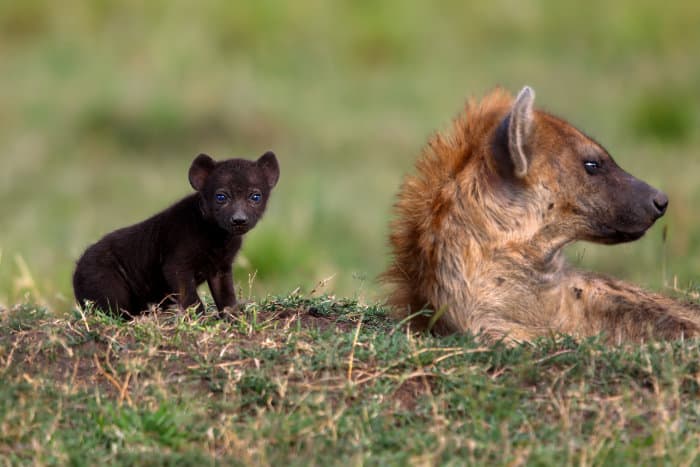
Hyena cubs are rather strange-looking. They don’t quite look like grown-up hyenas. Nor do they look like a puppy. In fact, some may even say they look like bear cubs.
Given that there are four species of hyena, the pups come in all shapes and sizes.
The baby spotted hyenas weigh around 1.5 kg at birth. They come out with soft, brownish-black fur, but as the days pass by, they’ll slowly change their appearance. Their fur begins to turn a sandy brown and they’ll start getting their adult spots.
While the striped hyena cub has adult markings and tiny ears, the brown hyena pup is the scruffiest of them all. With a long wiry coat, and big, bat-like ears.
Hyena Labor is Not Something to Laugh About
If you consider the sheer size of hyenas, which are a lot bigger than domestic dogs, their labor is rather impressive. Their powerful bone strength makes labor no easy task.
How hyena pups come into being
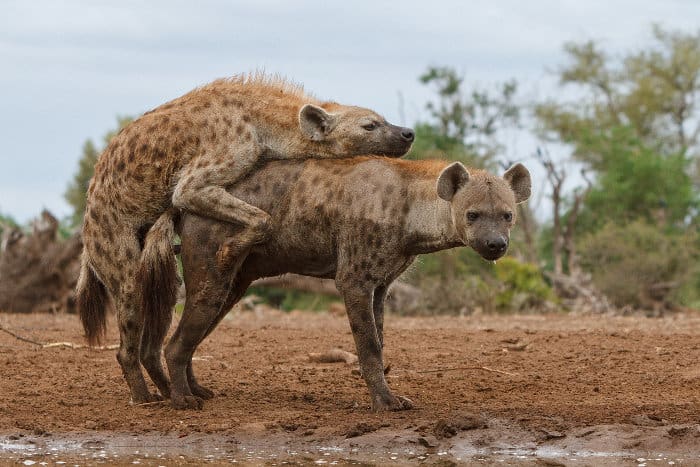
There’s no seasonal breeding when it comes to hyenas, so the right mood and right man is all they need for successful breeding. Although ‘man’ wouldn’t actually be the right word.
Female hyenas have a thing for younger mates, and often those who are from the same clan. The younger males also show more submissive behavior – a plus for the females.
They’re quite the promiscuous species, and there’s no life-long mating for any of these hyenas. They do however prefer males who they’ve had friendly relationships with.
Hyena gestation period
The gestation period of a hyena lasts around 110 days, which is quite a challenge out in nature. The more dominant females have this incredible ability to provide higher androgen levels. While lower-ranking females give off less of these hormones.
Female hyenas are tough cookies. A lot tougher than the males actually. Which is extremely bizarre in nature. They have three times more testosterone than their fellow males. This makes them significantly stronger and more aggressive.
And you’re wrong if you thought it couldn’t get any stranger. Although they have a vagina, females have a pseudo-penis, too. It’s part of the reason we’ll never know if we’re looking at a male or female hyena.
Because of this pseudo-penis, mating is more challenging for the male than any other species. It also ensures that rape doesn’t happen and that females can choose their mates freely.
How do hyenas give birth?
That pseudo-penis is not handy when it’s time to deliver two or three pups. Females have to deliver the pups through the small hyena birth canal. It’s a traumatic experience for both the mother and the cubs.
They’re the largest carnivore young in relation to their mother’s weight. This causes delivery to be extremely painful and laborious. A sad reality for hyenas is that there are cases in which the cubs will die due to suffocation during this tough birthing process.
There’s a high death rate among first-time mothers, as their birth canal is only 10 cm long, which often ruptures. This can take weeks to heal, putting the mother and her cubs in great danger.
Where does a hyena birth take place?
Much of a hyena’s life revolves around a communal den. Some of these dens they’ll keep for years, while some clans will move around a couple of times throughout their lifespan.
These dens are incredible formations, and play a huge role in the socialization of the clan. You’ll catch the hyenas lounging in the sun and nursing their cubs here. It’s not uncommon to see up to 20 cubs occupying the den.
The den is the hyena birthing place. Which happens either in the shared den or in a private birthing chamber, away from predators and male hyenas. The private den gives the hyenas a chance to bond with their cubs before they head out to meet the rest of the clan.
Taking Care of Hyena Cubs
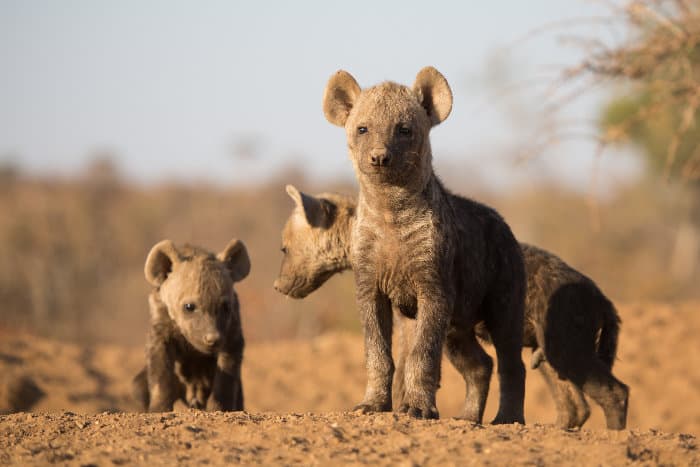
Hyena mothers are one of the most devoted mothers of all carnivores. They didn’t go through all of that effort delivering the cubs, to not raise them properly.
Remaining in the surrounding den area gives the hyena cubs a greater chance of survival. When their mothers need to go hunting, there’s always a babysitter on hand.
And like many other animal species, males play no role in raising the cubs.
Staying near the den means that the cubs get plenty of time to build up strength and test out their fighting skill with other young hyenas. It’s also the best opportunity to learn appropriate social skills and bond with the rest of the clan.
While we all recognize the hyena’s laugh, the cubs make an even stranger sound. Squitting, the sound produced sounds similar to nails grating against a chalkboard. Incredibly horrific, however, it grabs their mother’s attention and lets them know that they’re hungry little cubs.
Hyena Baby Behavior
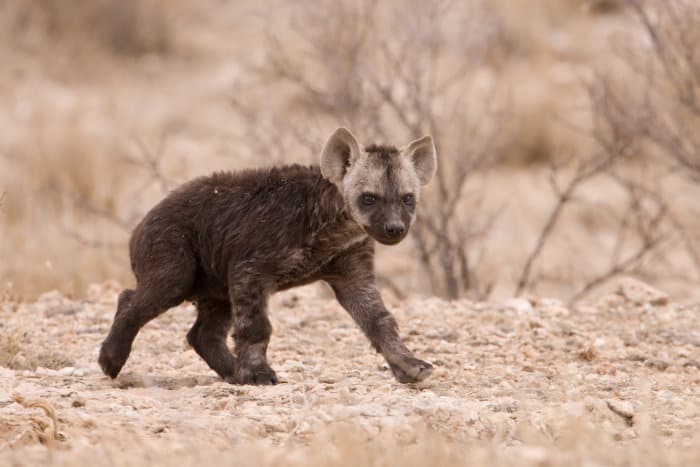
From the moment these babies open their eyes, they’re ready to take on the world. And each other for that matter. The cubs will start attacking each other and showing dominance from the minute they’re born.
They’ll often try to kill off their siblings to ensure that they receive the most milk – and it’s generally a lot worse with same-sexed siblings. This neonatal siblicide, unfortunately, kills up to 25% of all hyena cubs.
Hyena cubs are fast learners. From as young as one month, the cubs already exhibit adult behavior. As adults, they’re fast runners and can run for long distances. From as young as 10 days old, hyena cubs are whizzing around playfully with other cubs.
Once the cubs are one month old, they’ll give each other a few sniffs. This indicates that they’re friendly and ready to bond with other hyenas. Although, they won’t be too friendly as they’ll already start marking their territory to let others know who’s the boss.
Baby hyenas eating patterns

Of all the carnivore species on land, the milk of the female hyena has the highest fat and protein concentration. They can even carry 3-4 kg of milk in their udders at a time. It’s no wonder these creatures have the power to steal away a lion’s meal.
The cub’s mother will be producing milk for about a year, but it won’t be the only thing that they’re snacking on. From as young as 5 months, the cubs can start digesting raw meat. Their mothers don’t even need to regurgitate it for them.
When they reach 1 year, the hyena cubs no longer require a babysitter when their mother goes hunting. Instead, they’ll be able to join in on the fun and learn a thing or two from the females of the clan.
Unique Features of the Spotted Hyena Cub
One thing that stands out with the spotted hyena cubs is that their eyes are open at birth. This is a particularly interesting discovery, given that the striped hyenas and brown hyenas have closed eyes.
It’s as though the spotted hyena cub is ready for action as soon as it leaves its mother’s womb. With 6-7 mm long canine teeth and 4 mm incisors, you wouldn’t want to be cuddling one of these cubs.
Hyena Cubs – They Deserve a Standing Ovation
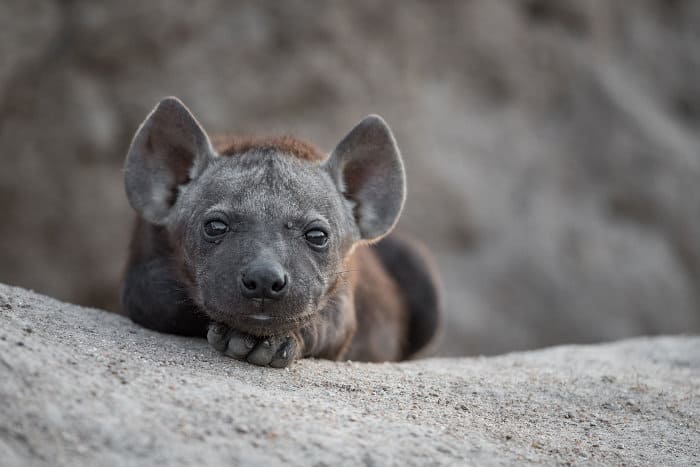
These feisty little pups have a bite bigger than their bark. After all, they’ve got to assert their dominance to stand up to females or hunt for food.
Thanks to their mothers, and elevated androgen levels, these pups are beyond brave. Their physical features and feisty attitudes make them remarkable creatures.
For a chance to see these incredible pups, plan and book a safari here!


